The Valley of the Kings
Geography of the Valley
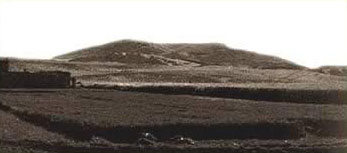 The
first king of the New Kingdom, Ahmose of the 18th Dynasty,
built a pyramid-like structure at Abydos, which may or may
not have been his original tomb. But all the remaining rulers
of the period, except for the so-called Amarna interregnum,
had their tombs cut into the rocks of the West Bank at Thebes,
specifically at the Valley of the Kings. From Thutmose I in
the 18th Dynasty of the New Kingdom period, all the kings,
and occasionally high officials of that period, were buried
in the secluded wadi, or dry gully, which today is called
Valley of the Kings.
The
first king of the New Kingdom, Ahmose of the 18th Dynasty,
built a pyramid-like structure at Abydos, which may or may
not have been his original tomb. But all the remaining rulers
of the period, except for the so-called Amarna interregnum,
had their tombs cut into the rocks of the West Bank at Thebes,
specifically at the Valley of the Kings. From Thutmose I in
the 18th Dynasty of the New Kingdom period, all the kings,
and occasionally high officials of that period, were buried
in the secluded wadi, or dry gully, which today is called
Valley of the Kings.
The peak known in Arabic as el-Qurn was known in
ancient times as dehent, the Horn, and was sacred to the goddesses
Hathor and Meretseger, "She who loves Silence."
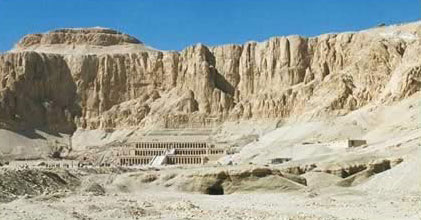 The
Valley, known as Biban el-Muluk, "doorway or gateway of the
kings," or, the Wadyein, meaning "the two valleys," is actually
composed of two separate branches. The main eastern branch,
called ta set aat, or "The Great Place," is where most of
the royal tombs are located, and in the larger, westerly branch
where only a few tombs were cut.
The
Valley, known as Biban el-Muluk, "doorway or gateway of the
kings," or, the Wadyein, meaning "the two valleys," is actually
composed of two separate branches. The main eastern branch,
called ta set aat, or "The Great Place," is where most of
the royal tombs are located, and in the larger, westerly branch
where only a few tombs were cut.
The Valley is hidden from sight, behind the cliffs,
which form the backdrop to the temple complex of Deir el-Bahri.
Though the most direct route to the valley is a rather steep
climb over these cliffs, a much longer, shallower, route existed
along the bottom of the valley. This was quite possibly used
by funeral processions, pulling funeral equipment by sledges
to the rock-cut tombs in the Valley.
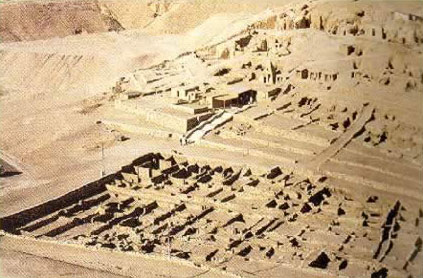 With
its worker’s village later called Deir el-Medina, the valley
was called the Place of Truth or Set Ma’at, in ancient times.
The workers of Deir el-Medina, who for generations since their
community was established, could reach the Valley in about
30 minutes by walking along the steep mountain paths. Today,
energetic folks may spend 45 minutes to an hour climbing the
paths leading from the north side of the amphitheater of Deir
el-Bahri and over the mountain ridge into the Valley of the
Kings. Their efforts would be rewarded by splendid views of
the Theban region.
With
its worker’s village later called Deir el-Medina, the valley
was called the Place of Truth or Set Ma’at, in ancient times.
The workers of Deir el-Medina, who for generations since their
community was established, could reach the Valley in about
30 minutes by walking along the steep mountain paths. Today,
energetic folks may spend 45 minutes to an hour climbing the
paths leading from the north side of the amphitheater of Deir
el-Bahri and over the mountain ridge into the Valley of the
Kings. Their efforts would be rewarded by splendid views of
the Theban region.
Tombs in the Valley
The Valley contains 62 tombs to-date, excavated by
the Egyptologists and archaeologists from many countries.
Not all of the tombs belonged to the king and royal family.
Some tombs belonged to privileged nobles and were usually
undecorated. Not all the tombs were discovered intact, and
some were never completed.
The powerful kings of the 18th and 19th Dynasties
kept the tombs under close supervision, but under the weaker
rulers of the 20th Dynasty, the tombs were looted, often by
the very workers or officials supposedly responsible for their
creation and protection. In order to prevent further thefts,
the mummies and some of their funerary objects were reburied
in two secret caches, not to be re-discovered until the 19th
century of the modern era.
Visitors to Egypt have often journeyed into the Valley
to view the accessible tombs, including Tut’s, but with the
increasing tourism, urban and industrial growth, pollution,
and rising groundwater, the tombs have suffered over the decades.
Today their access is rotated, so that a smaller number of
tombs are open at one time, and even then, many of the decorations
and walls can only be seen behind glass.
According to Diodorus and Strabo, and Greek and Latin
graffiti, two writers of ancient times, a few of the tombs
in the Valley of the Kings were known and visited by ancient
tourists during Ptolemaic times. Today, only a few of the
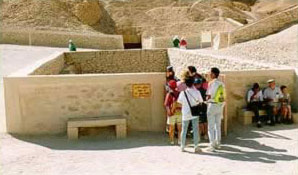 62
known tombs are accessible and open to the public. Eleven
of the tombs, including Tutankhamun’s, Ramesses VI, Amenhotep
II, and Seti I, have been set with electrical lighting.
62
known tombs are accessible and open to the public. Eleven
of the tombs, including Tutankhamun’s, Ramesses VI, Amenhotep
II, and Seti I, have been set with electrical lighting.
Right: Entrance to Tutankhamun's Tomb
The earliest king buried in the Valley was Thutmose
I, the latest, Ramesses XI. In 1922, Howard Carter found the
last and possibly most well-known of these tombs, that belonging
to the young King Tutankhamun. It lies directly opposite the
tomb of Ramesses IX. For all the amount of treasure that had
been found in this tomb, the space itself is small, and all
but one room was undecorated.
Directly across from Tutankhamun’s tomb lies KV5,
where work continues to uncover what may be the last resting
place of the 150 sons of Ramesses II.
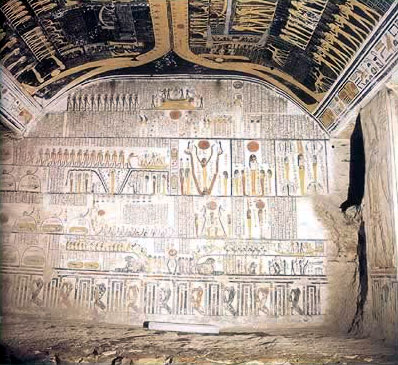 Ramesses
VI had one of the largest tombs in the valley. His tomb is
decorated with scenes from the books of the underworld, and
the burial chamber is dominated by the shattered remains of
the king’s massive granite sarcophagus.
Ramesses
VI had one of the largest tombs in the valley. His tomb is
decorated with scenes from the books of the underworld, and
the burial chamber is dominated by the shattered remains of
the king’s massive granite sarcophagus.
Left: Tomb of Ramesses VI
The tomb of Ramesses I, who had a brief reign, is
a single small chamber at the end of a steep corridor. It
bears some similarity in its decoration with the tomb of Horemheb,
while being more elaborate. The tomb of Merneptah, 13th son
and successor of Ramesses II, is badly damaged but worth visiting.
Psusennes I appropriated one of the sarcophagi for his own
burial at Tanis.
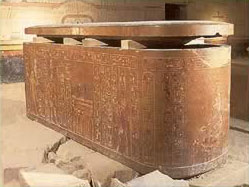 The
tomb of Thutmose III is the earliest-era tomb that can be
visited. Its walls are covered with 741 different deities
and its ceiling is spangled with stars. The first of the tombs
usually accessible is that of Ramesses IX, listed as tomb
6, right next to Tomb 55, now inaccessible.
The
tomb of Thutmose III is the earliest-era tomb that can be
visited. Its walls are covered with 741 different deities
and its ceiling is spangled with stars. The first of the tombs
usually accessible is that of Ramesses IX, listed as tomb
6, right next to Tomb 55, now inaccessible.
Right: Tuthmosis III Sarcophagus
The tomb of Seti I is the largest and most elaborate
of the royal tombs. It is often closed to visitors because
of rock falls and a lack of ventilation. Giovanni Belzoni,
the Patagonian Samson, first entered this tomb in 1817 and
brought back the alabaster sarcophagus and canopic chest to
England, where they rest in the John Soane Museum. Some large
wooden statues of Seti I similar to the black and gilt statues
of Tutankhamun now stand in the British Museum.
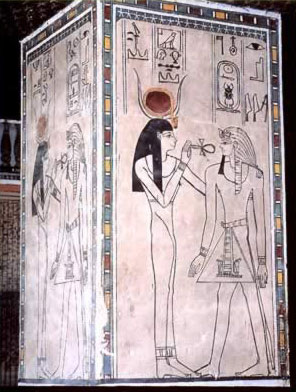 The
tomb of Ramesses II was begun for his father, Seti I, but
abandoned, because the corridor cut into the adjacent tomb
of Amenmesse. Belzoni removed the cartouche-shaped sarcophagus
lid and it now rests in the Fitzwilliam Museum in Cambridge.
The box sits in the Louvre.
The
tomb of Ramesses II was begun for his father, Seti I, but
abandoned, because the corridor cut into the adjacent tomb
of Amenmesse. Belzoni removed the cartouche-shaped sarcophagus
lid and it now rests in the Fitzwilliam Museum in Cambridge.
The box sits in the Louvre.
Left: Column in tomb of Amenhotep II
Situated at the southern end of another wadi is the
tomb of Amenhotep II. In 1898, in its southwest chamber was
found one of the caches of royal mummies. This tomb’s seclusion
made it a good reburial place for the nine royal mummies placed
here in order to protect them from further depredations. Thutmose
IV, Amenhotep III, Siptah, and Seti II were among the re-buried.
Amenhotep II was found still lying in his own sarcophagus.
Along with royal tombs, tombs belonging to officials
were found more or less intact. One was Maiherpra, a Nubian
prince educated at court with the royal princes, one of which
became Amenhotep II. Subsequently Maiherpra held office under
that king.
History of Egyptology in the Valley
The Classical Greek writers Strabo and Diodorus Siculus
were able to report that the total number of Theban royal
tombs was 47, of which at the time only 17 were believed to
be undestroyed. Pausanias and others wrote of the pipe-like
corridors of the Valley, tombs into which travelers could
descend and admire the wall decorations.
Some of these travelers left their names and other
marks. The earliest datable graffito in the Valley was found
in the tomb of Ramesses VII, and can be dated to 278 BCE,
and the latest, left by a governor of Upper Egypt was dated
to 537 ACE. The French scholar Jules Baillet counted over
2000 Greek and Latin graffiti left over the Classical centuries,
along with a lesser number in Phoenician, Cypriot, Lycian,
Coptic, and other languages. Almost half of these were found
in the tomb of Ramesses VI, who was considered to be the fabled
Memnon himself.
After the Arabs came into Egypt in 641 ACE, interest
in the Valley waned considerably. It was not until the end
of the 16th century that once again travelers began once again
to take notice. Although the location of Thebes was clearly
marked on a map of 1595, in 1668 a Father Charles Francois
visited "the place of the mummies" and apparently did not
realize its significance. It was left to another Frenchman,
Father Claude Sicard, head of the 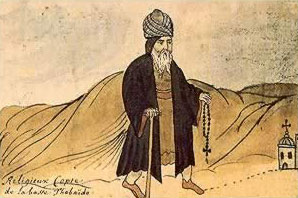 Jesuit
Mission in Cairo, traveling in Egypt between 1714 and 1726,
who visited in the Valley in 1708 and located 10 open tombs
including that of Ramesses IV. He wrote of the extensive wall
paintings and their colors.
Jesuit
Mission in Cairo, traveling in Egypt between 1714 and 1726,
who visited in the Valley in 1708 and located 10 open tombs
including that of Ramesses IV. He wrote of the extensive wall
paintings and their colors.
Left: Father Claude Sicard
Sicard’s notes for the most part were unfortunately
lost, and thus the first significant published account of
the Valley was left to an Englishman named Richard Pococke
in 1743. He apparently noted signs of about 18 tombs, though
believing that only nine of these could be entered. In 1768
a Scotsman named James Bruce visited Luxor and explored the
Valley. He visited the tombs of Ramesses IV and of Ramesses
III, henceforth known as "Bruce’s Tomb." The principal feature
of the latter tomb, for Bruce, were the fresco scenes of three
harps.
William George Brown visited the Valley in 1792,
and he left his name in the tomb of Ramesses III. He also
recounted one of the few extant accounts of contemporary Arab
interest and excavation at the site. Browne wrote that the
site had been explored "in the last 30 years" by a certain
son of a Sheikh Hamam, but it is unknown whether or not this
person was successful. Browne also described several tombs
to which he had access, three of which did not seem to tally
with descriptions given by Richard Pococke.
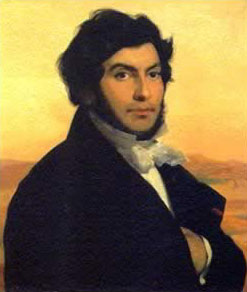 After
Napoleon’s Expedition in 1798, two Frenchmen named Prosper
Jollois and Edouard de Villiers du Terrage recorded the position
of 16 tombs. For the first time the existence of a western
branch of the valley was recorded, including the tomb of Amenhotep
III. Jollois and de Villiers were to publish their works in
the 19 volume Description de l’Egypte.
After
Napoleon’s Expedition in 1798, two Frenchmen named Prosper
Jollois and Edouard de Villiers du Terrage recorded the position
of 16 tombs. For the first time the existence of a western
branch of the valley was recorded, including the tomb of Amenhotep
III. Jollois and de Villiers were to publish their works in
the 19 volume Description de l’Egypte.
Right: Jean Francois Champollion
One of the great names of early Egyptology has to
be that of Champollion, for his work in translating the ancient
hieroglyphic symbols on the Rosetta Stone and thus opening
the door to a greater understanding of the lives of these
people. But though this work and his beautiful drawings published
in his Monuments de l’Egypte et de la Nubie left a brilliant
legacy for scholars who followed him, he also left a legacy
of shoddy and misguided destruction. Champollion and his companion
Rossellini removed two scenes from the tomb of Seti I, which
they brought to the Louvre and to a museum in Florence.
Giovanni Belzoni, called the Patagonian Samson, was
the first modern-era European to visit the Valley of the Kings.
He was sponsored by the Englishman Henry Salt, Consul-General
in Egypt in 1816. Among other treasures, 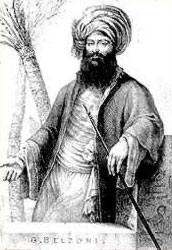 Belzoni
removed from Egypt the sarcophagus of Ramesses III from "Bruce’s
Tomb," and it now lies in the Louvre and the Fitzwilliam Museums.
To give him some credit, Belzoni also not only confirmed the
presence of the 47 tombs known to Classical writers, but added
a further 8 tombs to that list, including those of King Ay,
Prince Mentuherkhepshef, and Ramesses I. Belzoni’s most well-known
find in the Valley was the tomb of Seti I, the finest so far
found.
Belzoni
removed from Egypt the sarcophagus of Ramesses III from "Bruce’s
Tomb," and it now lies in the Louvre and the Fitzwilliam Museums.
To give him some credit, Belzoni also not only confirmed the
presence of the 47 tombs known to Classical writers, but added
a further 8 tombs to that list, including those of King Ay,
Prince Mentuherkhepshef, and Ramesses I. Belzoni’s most well-known
find in the Valley was the tomb of Seti I, the finest so far
found.
Left: Giovanni Belzoni
After Belzoni’s escapades, scholars began to emphasize
recording and studying what had been found in the Valley,
rather than simply searching for more tombs. John Gardner
Wilkinson, born in Chelsea, England in 1797 excavated in the
Valley in 1824 and in 1827-28.at his own expense. Except for
the West Valley, which he numbered separately, Wilkinson physically
assigned a number to each tomb entrance, still visible today.
Tombs KV1-21 are marked on the map of the main valley in his
Topographical Survey of Thebes of 1830.recorded in 1827 that
21 tombs were open to view, listing them in chronological
order. He copied scenes and inscriptions and then published
the first accurate account of the tombs, titled Topography
of Thebes, in 1830.
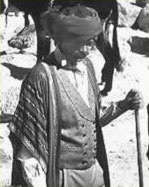 James
Burton was a contemporary of Wilkinson in Thebes. He began
a clearance of the tomb listed as KV20, which he had to abandon
due to "bad air" and only later would be proven by Howard
Carter to be the tomb of Thutmose I and Hatshepsut. Burton
also began a superficial examination of the tomb later called
KV5. This tomb would wait until the 20th century to prove
itself as the largest tomb to-date, most probably cut to serve
the family of Ramesses II. At least 50 of his children have
been found so far to have been buried therein. Burton published
no records of his work, though some 63 volumes of his notes
and drawings were given to the British Museum upon his death
in 1862.
James
Burton was a contemporary of Wilkinson in Thebes. He began
a clearance of the tomb listed as KV20, which he had to abandon
due to "bad air" and only later would be proven by Howard
Carter to be the tomb of Thutmose I and Hatshepsut. Burton
also began a superficial examination of the tomb later called
KV5. This tomb would wait until the 20th century to prove
itself as the largest tomb to-date, most probably cut to serve
the family of Ramesses II. At least 50 of his children have
been found so far to have been buried therein. Burton published
no records of his work, though some 63 volumes of his notes
and drawings were given to the British Museum upon his death
in 1862.
Karl Richard Lepsius followed both examples, that
of scholarly recording and that of removing artifacts from
their original place of rest. In 1844, Lepsius led a Prussian-backed
expedition to Egypt. After years of exploring, mapping, and
drawing pyramids, tombs, and monuments, including the Valley
of the King tombs, Lepsius returned 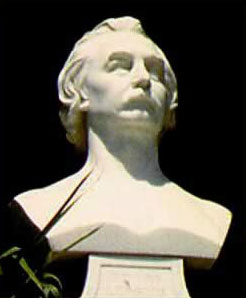 and
produced the twelve-volume work Denkmaler aus Agypten und
Athiopien. But he also sent out of Egypt 15,000 pieces, and
at one time, overthrowing a decorated column in Seti’s tomb
merely in order to remove a portion of it, leaving the rest
in wreckage on the floor.
and
produced the twelve-volume work Denkmaler aus Agypten und
Athiopien. But he also sent out of Egypt 15,000 pieces, and
at one time, overthrowing a decorated column in Seti’s tomb
merely in order to remove a portion of it, leaving the rest
in wreckage on the floor.
Left: Karl Richard Lepsius
In the latter half of the 19th century, this plundering
would come to a close. Auguste Mariette laid the foundations
of a national Egyptian museum and for a governmental antiquities
service. It was Mariette who discovered the Serapeum, the
burial place at Memphis of the sacred Apis bulls, and the
intact burial of Queen Ahhotep, mother of Ahmose, the founder
of the New Kingdom. But Mariette’s greatest contribution to
Egyptology was the formation of the Antiquities Service. As
Director-General, he was responsible for awarding concessions
to all excavators, monitoring all digs, and policing the export
of antiquities.
When the first cache of royal mummies was discovered
in 1881 at Hatshepsut’s temple of Deir el Bahri, world attention
was once and for all focused on the quiet valley, and the
first of many new excavations began in the area. Victor Loret
arrived in Luxor in 1898. Loret had been appointed as the
Director-General of the Antiquities Service, established by
Mariette in 1856. Only five days after he began to dig below
the cliffs under the Qurn, or "Horn" mountain, his team discovered
the tomb of Thutmose III. He added 16 tombs to the map of
the principal Valley. He also discovered the second cache
of royal mummies within the tomb of Amenhotep II.
But Loret was not well-liked, and upon his resignation
Maspero was reinstated. In 1899, Maspero appointed Howard
Carter to be Antiquities Inspector for Upper Egypt. His responsibilities
were to maintain all the sites of Upper Egypt and to grant
concessions for others to dig, rather than having the authority
to dig on his own. One of Carter’s claims to fame in this
job was that he installed the first electric lighting, handrails,
staircases and running boards in the royal tombs.
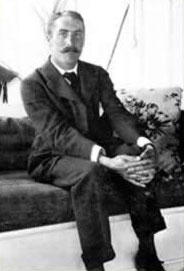 Financing
these improvements required the backing of investors, and
one such was the American Theodore Davis. Under his patronage,
Carter discovered the royal tomb of Thutmose IV, including
a wonderful royal chariot, and the tomb of Hatshepsut herself,
containing her sarcophagus and that of her father Thutmose
I.
Financing
these improvements required the backing of investors, and
one such was the American Theodore Davis. Under his patronage,
Carter discovered the royal tomb of Thutmose IV, including
a wonderful royal chariot, and the tomb of Hatshepsut herself,
containing her sarcophagus and that of her father Thutmose
I.
Right: Howard Carter
When Davis persuaded Maspero in 1903 that he could
no longer work with Carter, Maspero promoted Carter to Inspector
of Saqqara, but Carter resigned six weeks later and never
worked for the Antiquities Service again. Maspero replaced
him with James Quibell, but he too was eventually replaced,
by Arthur Weigall. Weigall was the one who broke through a
tomb entrance that Quibell had earlier discovered, to find
the rich burial goods and mummies of Yuya, Master of the King’s
Horse, and his wife Thuya, the parents of Tiye, wife of Amenhotep
III and mother of Amenhotep IV, later to rename himself Akhenaten.
More archaeologists and Egyptologists would follow,
and great finds would continue to be made. Many excavators
would return to Egypt and add astounding discoveries in the
Valley to their earlier finds. Howard Carter was one who kept
on working. For all the incredible efforts and discoveries
made in the Valley of the Kings, in past decades or within
just the past weeks, and all the contributions to the expansion
of our knowledge of the funerary practices and literature
and of the kingly history of ancient Egypt, all these seem
veritably overshadowed by the finds made that relate to just
one burial, the tomb and riches of the young King Tutankhamun.